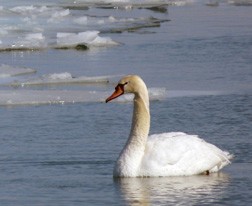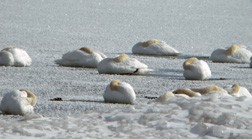The Majestic Mute Swan
- Share
- Tweet
- Pin
- Share
I sort through my “memory” files to come up with my first sighting of a Mute Swan. A photo taken by my mother in 1937, the year my dad got his new Chevrolet, shows my dad, my two older brothers and me resting after taking a very long hike through the Brookfield Zoo, or perhaps it was called the Brookfield Zoological Gardens, in Chicago. I distinctly remember seeing several majestic Mute Swans, heads held high, floating so regally with a few other swan species.
We had been visiting and staying with relatives in Racine and my dad decided we needed to see that great zoo in Chicago. He told us three boys, sitting in the back, to pay close attention to the street sign at each corner to make sure we still were on Ogden Ave. Apparently we had to follow that avenue for several miles.
Seeing my first wild Mute Swan on Moonlight Bay in Baileys Harbor didn’t occur until July 27, 1975, and naturally I did a story about that exciting occurrence. Our greatest thrill that day was to see this superlative flyer begin its long, tiptoeing takeoff, and with powerful slow motion wing beats, the wing tips gently touching the water, majestically take to the air. Prior to this experience all of the other Mute Swans I had seen were confined to parks or zoos. Their primary flight feathers had been clipped, making them prisoners.

This beautiful Mute Swan was photographed by Melody Walsh on Washington Island.
Imagine my surprise when I learned that Mute Swans can weigh up to 50 pounds. Little wonder this bird appeared to have to work so hard to become airborne. Trumpeter Swans weigh up to 38 pounds while Tundra Swans seldom weigh more than 20 pounds. The Mute Swan is the champion, the heaviest living flying bird in the world.
A trip Charlotte and I took to Lower Michigan in the autumn of 1979 gave us our closest and most exciting look at the Mute Swans. There in the Traverse Bay Region, and in the lower Hudson Valley of southeastern New York, sizeable resident flocks of Mute Swans had become the largest naturalized species of exotic birds in America.
Can you imagine Mute Swans becoming as common as European Starlings and Common Grackles that they no longer command one’s attention? Worse still, can you visualize these large birds contributing greatly toward the eutrophication of dozens of ponds and small lakes, driving thousands of native ducks, geese and other water birds out of their nesting habitats, and in general the swans becoming great nuisances?
Consider the situation in many coastal regions of southern New England. A story, “A Dilemma of Swans” by Ted Williams, appeared in the July 1980 issue of Yankee Magazine to which I used to subscribe. Thousands of residents, particularly of Connecticut and Rhode Island, to whom the Mute Swan was a wonderful new white creature, were extremely emotional about them. After all, most everyone recognizes these astounding white birds as symbols of beauty, dignity and immortality.
However, Bruce Fellman, a Rhode Island naturalist, summed up the situation perfectly when he said, “What a majestic bird! What grace and beauty! And what an awful pain in the neck!”
If you’ve ever tried walking down a lakeside road or shore frequented by several hundred Canada Geese, you are well aware of the unbelievable quantity of manure to vainly attempt to avoid stepping in!
Fifty swans resting on a little pond at night, each bird having eaten as much as 14 pounds of aquatic vegetation elsewhere during the day, can be a more severe source of pollution to that body of water than a dozen malfunctioning septic tanks.
People of Trustrum Pond, associated with the Audubon Society in Rhode Island, had a terrible problem with a resident flock of between 250 and 275 Mute Swans. Imagine the amount of swan manure along that shore alone!
I have no doubt that presently there may be some people, who have observed, photographed and enjoyed the 50-plus Mute Swans which have been wintering recently on Cana Island Bay in northeastern Door County, wishing that this large flock will remain in that area this coming summer and perhaps become a resident flock. My guess is that these birds are part of the large resident flock that nest across the lake in Lower Michigan at Traverse Bay, and somehow drifted westward to our area this early winter and will return to Traverse Bay in spring.

Mute Swans enjoying a cold rest.
The important point to realize is that Mute Swans are not native to North America. The swans were brought here from Europe many years ago and gradually are becoming firmly naturalized in America. Just think of what all of us ancestors of primarily Europeans have done to the overall environment in this country.
In spite of the uproar of many people, intensive controls are called for. The trouble is, how does one eliminate or limit the numbers of Mute Swans without a public outcry? Obviously it would have been best to prevent the big white birds from becoming established in the first place. My gut feeling is that there are plenty of Native American Indians who look at us white people the same way.
As far as I am concerned, let’s not allow another exotic, this one being white and weighing as much as 50 pounds, to become implanted in Wisconsin and eventually produce a threat to the native plants, animals and small bodies of water. After long and serious thought I have come to the conclusion that the best place for Wisconsinites to see Mute Swans is in a zoo or, better yet, at the ballet!
